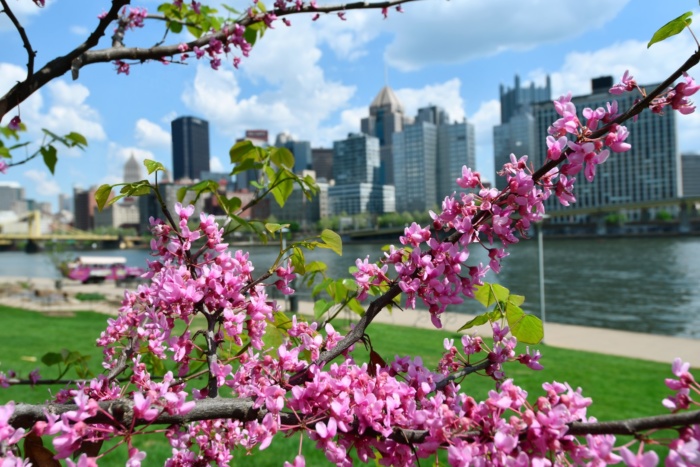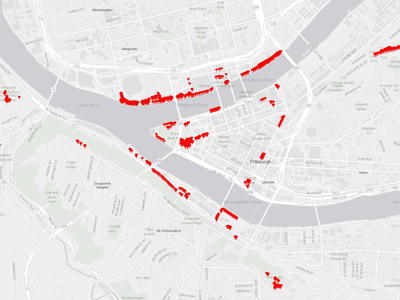Pittsburgh, Pa. – April 16, 2021 – Pittsburgh’s residents and visitors are seeing a flourish of pink blooms right now along trails, hillsides, parks and open spaces in view of the Allegheny, Monongahela and Ohio rivers around downtown Pittsburgh and near Point State Park. That is thanks to the Pittsburgh Redbud Project, an initiative of the Western Pennsylvania Conservancy, to help reforest the city’s riverfronts with native trees and shrubs.
The project began in 2016 with the planting of 60 redbud trees along the Three Rivers Heritage Trail near Heinz Field. Over the past five years, the Conservancy, along with its volunteers and partners, have planted 3,267 trees as part of the project.
Although the native Eastern redbud is the predominant tree planted for the project, with 1,581 planted to date, cherry, birch, spruce, hophornbeam and hawthorn are among the complementary species bringing natural color and wildlife habitat to the riverfronts.
Trees have been planted over 10 spring and fall planting seasons along the Three Rivers Heritage Trail near the Carnegie Science Center, Heinz Field and PNC Park, and along River Avenue on the North Shore Riverfront Trail. In downtown Pittsburgh, several redbud trees line the entryway to Point State Park, Gateway Islands median, and along Grant Street.
Frank Curto, Grandview and West End Overlook parks also now have redbud and other trees in addition to locations on Allegheny Landing, at Station Square and along West Carson Street.
 Jeff Bergman, director of community forestry and TreeVitalize Pittsburgh at the Conservancy, says the project is helping to beautify and reforest these highly visual areas and encourages the public to visit these locations to see the vibrant blooms of the redbuds.
Jeff Bergman, director of community forestry and TreeVitalize Pittsburgh at the Conservancy, says the project is helping to beautify and reforest these highly visual areas and encourages the public to visit these locations to see the vibrant blooms of the redbuds.
“The thousands of new native trees and vegetation will also help reduce the amount of stormwater runoff and pollutants entering the rivers, improve habitat for wildlife and help decrease air pollution,” says Bergman. “These benefits will just continue to enhance the city’s tree canopy year after year as the trees become more established.”
The project idea was developed by Frank Dawson, a landscape architect who was inspired by the natural beauty of the redbud tree, downtown Pittsburgh and the popular cherry blossoms in Washington, DC. Pittsburgh Redbud Project partners include Riverlife and the City of Pittsburgh, and is funded by Colcom Foundation.
“The Western Pennsylvania Conservancy has made Pittsburgh a springtime destination to celebrate the spectacular redbud blooms,” says Colcom Foundation President and Chief Investment Officer John Barsotti.
FREE WEBINAR: Thurs., April 22, 2021 (Earth Day), 12:30-1:30 p.m. EDT
The Conservancy is hosting a free webinar celebrating the Pittsburgh Redbud Project and Pittsburgh’s riverfronts and greenspaces. Registration is available now and open to the public at WaterLandLife.org/Webinars.
###
About the Western Pennsylvania Conservancy:
The Western Pennsylvania Conservancy (WPC) enhances the region by protecting and restoring exceptional places. A private nonprofit conservation organization founded in 1932, WPC has helped to establish 11 state parks, conserved more than a quarter million acres of natural lands and protected or restored more than 3,000 miles of rivers and streams. The Conservancy owns and operates Frank Lloyd Wright’s Fallingwater, which is now on the UNESCO World Heritage List and symbolizes people living in harmony with nature. In addition, WPC enriches our region’s cities and towns through 132 community gardens and other green spaces that are planted with the help of more than 3,000 volunteers. The work of the Western Pennsylvania Conservancy is accomplished through the support of more than 9,000 members. For more information, visit WaterLandLife.org or Fallingwater.org.
Media Contact:
Carmen Bray
Director of Communications for WPC
412-586-2358
cbray@paconserve.org
